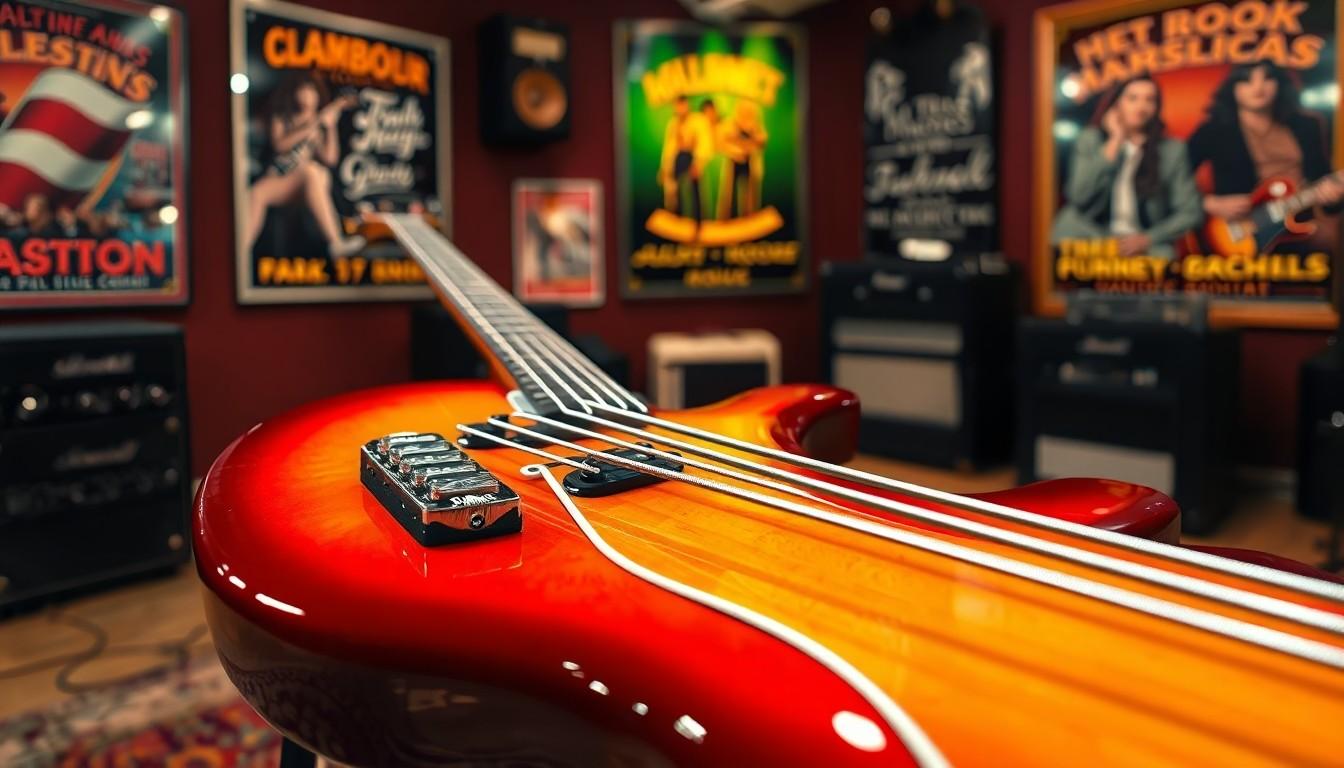Learning to play bass guitar doesn’t have to feel like climbing Mount Everest with your fingers. Whether you’re a complete beginner or just looking to expand your repertoire there’s a whole world of simple yet groovy bass lines waiting to be discovered.
From classic rock anthems to modern pop hits many popular songs feature straightforward bass lines that sound impressive but won’t tie your fingers in knots. These beginner-friendly tunes not only help build essential skills but also boost confidence as new bassists master their first songs. The best part? They’ll have you sounding like a pro without requiring years of practice.
Easy Bass Songs
Bass guitar fundamentals form the foundation for playing easy songs. Learning these core concepts enables beginners to start playing recognizable tunes quickly.
Reading Bass Tablature
Bass tablature provides a visual representation of where to place fingers on the fretboard. A tab displays six horizontal lines representing the four strings of a bass guitar, with numbers indicating specific frets to play. The bottom line represents the thickest string (E), while the top line represents the thinnest string (G). Numbers on the lines show which fret to press, and a ‘0’ indicates playing an open string. Standard tab symbols include:
-
- ‘h’ for hammer-ons
-
- ‘p’ for pull-offs
-
- ‘x’ for muted notes
-
- ‘/’ for slides
Essential Bass Techniques
Proper finger placement creates clear notes on the bass guitar. The fretting hand uses the index, middle, ring, and pinky fingers to press strings against frets, while the plucking hand employs the index and middle fingers to strike strings. Key techniques include:
-
- Alternating finger plucking
-
- Palm muting for controlled sound
-
- One finger per fret positioning
-
- Proper thumb placement on back of neck
-
- String muting with fretting hand
These techniques contribute to developing muscle memory patterns for playing bass lines smoothly. Regular practice of these fundamentals builds the coordination needed for playing songs.
Classic Rock Songs for Beginners

Classic rock offers numerous iconic bass lines that combine simplicity with memorable melodies, making them perfect for novice bass players to master essential techniques.
“Seven Nation Army” by The White Stripes
The signature bass line in “Seven Nation Army” features a distinctive seven-note pattern played entirely on the E string. The riff consists of descending notes: E, E, G, E, D, C, B, making it accessible for beginners with minimal finger movement. Players start at the 7th fret and move down the fretboard, following a straightforward rhythm pattern. The tempo remains steady at 124 BPM, allowing new bassists to focus on accuracy rather than speed. The repetitive nature of this bass line helps develop muscle memory while practicing fundamental techniques like proper fretting hand positioning.
“Another One Bites the Dust” by Queen
John Deacon’s legendary bass line in “Another One Bites the Dust” centers on a three-note groove played on the D and A strings. The pattern repeats throughout most of the song at 110 BPM, incorporating slides between the 3rd and 5th frets. The main riff uses the notes D, D, A, creating a funky groove that’s recognizable within the first few seconds. Beginning bassists benefit from practicing this song as it teaches essential techniques like string crossing muting. The consistent rhythm pattern helps develop timing skills while maintaining a solid foundation with the drums.
Simple Funk and R&B Bass Lines
Funk and R&B bass lines create infectious grooves through repetitive patterns and syncopated rhythms. These genres offer numerous accessible bass lines for beginners while teaching essential techniques like ghost notes and rhythmic precision.
“Billie Jean” by Michael Jackson
The bass line in “Billie Jean” centers on a hypnotic two-bar pattern at 117 BPM. Players start on the A string (7th fret) followed by the E string (7th fret), creating the iconic groove that drives the entire song. The pattern incorporates strategic rests between notes, teaching beginners the importance of space in bass playing. This bass line demonstrates proper fretting hand positioning through its consistent use of the seventh fret position across two strings.
| Technical Details | Values |
|---|---|
| Tempo (BPM) | 117 |
| Primary Fret Position | 7th |
| Main Strings Used | A, E |
| Pattern Length | 2 bars |
“Stand by Me” by Ben E. King
The bass line in “Stand by Me” follows a classic I-VI-IV-V progression at 118 BPM. The pattern starts on the root note E (open E string), moving through C♯, A, and B notes to create a walking bass feel. Each note receives equal emphasis on the quarter notes, making this line ideal for developing steady timing. The progression repeats throughout most of the song, allowing beginners to focus on maintaining consistent volume and note duration.
| Technical Details | Values |
|---|---|
| Tempo (BPM) | 118 |
| Key | E major |
| Chord Progression | I-VI-IV-V |
| Note Duration | Quarter notes |
Popular Alternative Rock Bass Songs
Alternative rock bass lines blend simplicity with distinctive melodies, creating an ideal starting point for beginners. These songs incorporate fundamental techniques while maintaining an engaging sound that resonates with modern audiences.
“Feel Good Inc.” by Gorillaz
The bass line in “Feel Good Inc.” centers on a four-bar pattern played at 138 BPM, featuring notes primarily on the E string. This track introduces players to chromatic movement between frets 3 and 5, teaching precise finger placement and timing. The rhythm follows a straightforward quarter-note pattern that repeats throughout most of the song, with occasional variations during the chorus. Bass players learn essential muting techniques by practicing the clean transitions between notes, ensuring each note rings clearly without unwanted string noise.
“Come as You Are” by Nirvana
The iconic bass line in “Come as You Are” follows a descending chromatic pattern at 120 BPM, utilizing the A and D strings. Players start on the 5th fret of the A string, moving down one fret at a time through a four-note sequence. The pattern employs eighth notes played with alternating index and middle fingers, developing crucial right-hand coordination. This bass line teaches players how to maintain consistent timing while incorporating hammer-ons and pull-offs between frets, enhancing left-hand dexterity.
Blues and Country Bass Lines
Blues and country music features straightforward bass lines that emphasize root notes and walking patterns. These genres provide excellent starting points for beginners due to their consistent rhythms and predictable progressions.
“Folsom Prison Blues” by Johnny Cash
The bass line in “Folsom Prison Blues” follows a classic walking pattern at 85 BPM. The progression utilizes quarter notes played on the E A D strings in sequence E-A-E-B7, creating the signature train-like rhythm. Each bar contains four notes that alternate between the root note and supporting chord tones. The pattern repeats throughout the song with minimal variation, making it ideal for developing timing and finger independence.
“Sweet Home Alabama” by Lynyrd Skynyrd
“Sweet Home Alabama” features a three-note root pattern played at 98 BPM on the D G D strings. The bass line alternates between D C G chords using quarter notes with occasional eighth-note transitions. Playing this line teaches essential string-crossing techniques while maintaining steady timing. The recurring pattern repeats every two bars, allowing beginners to focus on achieving clean note articulation and proper muting techniques. This song’s bass line demonstrates how simple root notes create a powerful foundation in southern rock.
Tips for Learning Bass Songs
Learning bass songs becomes more effective with structured practice methods focused on technique development. The following sections outline essential practice strategies and common pitfalls to avoid.
Practice Techniques
Starting with slow tempos builds a solid foundation for bass playing mastery. Players see improved results by practicing with a metronome at 60-80 BPM before gradually increasing speed. Breaking down complex passages into smaller segments allows focused attention on challenging parts. A structured 30-minute practice routine includes:
-
- Dedicating 10 minutes to finger exercises (chromatic scales left-hand patterns)
-
- Playing the song’s main riff 20 times consecutively without errors
-
- Recording practice sessions to identify areas for improvement
-
- Using isolated track practice to lock in with the drum pattern
-
- Implementing the 5-minute rule: mastering short sections before moving forward
Common Mistakes to Avoid
Bass players often encounter specific technical challenges that impede their progress. Here are critical errors to recognize:
-
- Gripping the neck too tightly creating hand fatigue tension
-
- Playing with inconsistent finger alternation patterns
-
- Rushing through difficult passages instead of maintaining tempo
-
- Neglecting proper muting techniques causing unwanted string noise
-
- Using excessive force when plucking strings
-
- Positioning the fretting hand thumb incorrectly on the neck
-
- Skipping fundamental exercises in favor of advanced techniques
Each practice session focuses on eliminating these issues through conscious monitoring technique adjustments.
Starting the bass guitar journey doesn’t have to be overwhelming. These easy-to-learn songs across different genres provide the perfect stepping stones for beginners to build their skills while having fun. From classic rock to funk R&B and alternative hits these songs offer valuable lessons in technique timing and groove.
With dedication regular practice and proper guidance any aspiring bassist can master these fundamental tracks. They’ll develop essential skills build confidence and create a solid foundation for more complex bass lines. The path to becoming a proficient bassist begins with these accessible songs that have stood the test of time.

